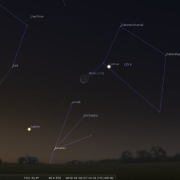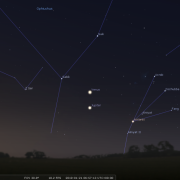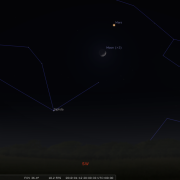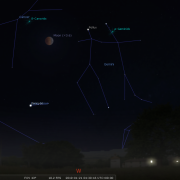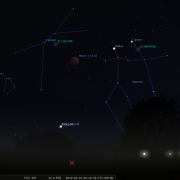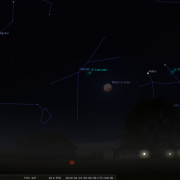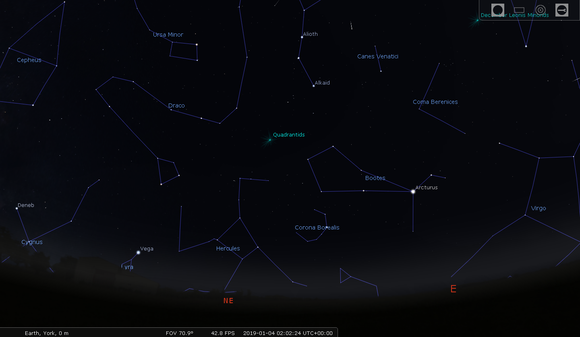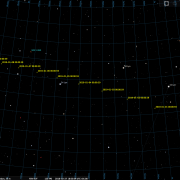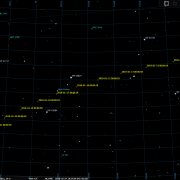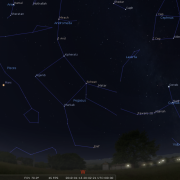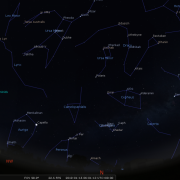In this month's Sky Notes:
- Planetary Skylights
- Moon: Total Lunar Eclipse
- Meteors
- Comets
- Earth at Perihelion
- January 2019 Sky Charts
Planetary Skylights
Morning
The dawn sky is the place for planetary action as the New Year commences.
 Venus totally dominates the early morning scene, a brilliant object across in the SSE that cannot be missed. Through a telescope look for the pleasing crescent phase, and as it’s a morning object see how long you can continue viewing Venus as skies brighten, you will be taken aback.
Venus totally dominates the early morning scene, a brilliant object across in the SSE that cannot be missed. Through a telescope look for the pleasing crescent phase, and as it’s a morning object see how long you can continue viewing Venus as skies brighten, you will be taken aback.
 If you have a flat South-East horizon you will also spot conspicuous Jupiter which is now making inroads into the dawn sky lower left of Venus. It is still rather low to appreciate through a telescope, but there will be plenty of time to view Jupiter telescopically.
If you have a flat South-East horizon you will also spot conspicuous Jupiter which is now making inroads into the dawn sky lower left of Venus. It is still rather low to appreciate through a telescope, but there will be plenty of time to view Jupiter telescopically.
 For the first few days of January elusive Mercury will still be visible, but you will need a flat SE aspect to spot it lower left of Jupiter. A slender waning crescent moon lies above/right of Mercury on the 4th at 07:30-07:40h. The day before the crescent moon is above left of Jupiter and the day before that it lies lower left of Venus.
For the first few days of January elusive Mercury will still be visible, but you will need a flat SE aspect to spot it lower left of Jupiter. A slender waning crescent moon lies above/right of Mercury on the 4th at 07:30-07:40h. The day before the crescent moon is above left of Jupiter and the day before that it lies lower left of Venus.
 Then at the end of January watch as the Crescent Moon again resides between Jupiter and Venus, by which time Jupiter and Venus have swapped places in the morning sky. Keep tabs on the pair over the course of the month as they draw closer together, with a spectacular conjunction on Jan 22nd when they are separated by 2.5 degrees. View around 7:15-07:30h.
Then at the end of January watch as the Crescent Moon again resides between Jupiter and Venus, by which time Jupiter and Venus have swapped places in the morning sky. Keep tabs on the pair over the course of the month as they draw closer together, with a spectacular conjunction on Jan 22nd when they are separated by 2.5 degrees. View around 7:15-07:30h.
Evening
 Mars continues to head eastwards along the ecliptic, and spends January moving up through Pisces and toward Uranus (next month). Telescopically glimpses of darker markings are possible, however as Earth continues to draw further away from the red planet, such views increasingly fall into the domain of larger apertures and imaging devices. The Moon resides below Mars on the 12th.
Mars continues to head eastwards along the ecliptic, and spends January moving up through Pisces and toward Uranus (next month). Telescopically glimpses of darker markings are possible, however as Earth continues to draw further away from the red planet, such views increasingly fall into the domain of larger apertures and imaging devices. The Moon resides below Mars on the 12th.
 Of the outer gas giants Uranus is well placed for observation during the evening across in the SSW. It has just moved over the border from Aries into Pisces and resides less than 1.5 degrees north of Omicron Piscium (look for ‘Torcular’ on star charts). It can be picked out in binoculars, but through a telescope you will easily spot the ghoulish soft green hue of its very small disk.
Of the outer gas giants Uranus is well placed for observation during the evening across in the SSW. It has just moved over the border from Aries into Pisces and resides less than 1.5 degrees north of Omicron Piscium (look for ‘Torcular’ on star charts). It can be picked out in binoculars, but through a telescope you will easily spot the ghoulish soft green hue of its very small disk.
 Neptune is becoming more difficult to track down as slides further down into the SW murk. View in the first half of the month around 6pm. It resides approximately a binocular field lower left of the asterism known as the ‘water jar’ in constellation of Aquarius’ and between the stars lamda and phi Aquarii, and on a smaller scale forms a triangle with 81 and 82 Aquarii. You will require a telescope to identify it, appearing as a tiny blue/grey disk.
Neptune is becoming more difficult to track down as slides further down into the SW murk. View in the first half of the month around 6pm. It resides approximately a binocular field lower left of the asterism known as the ‘water jar’ in constellation of Aquarius’ and between the stars lamda and phi Aquarii, and on a smaller scale forms a triangle with 81 and 82 Aquarii. You will require a telescope to identify it, appearing as a tiny blue/grey disk.
Total Lunar Eclipse
You will have to set the alarm for the highlight of the month, when there is a total lunar eclipse during the early morning hours of the 21st.
- Totality is centred on 05:12h, but…
- The penumbral part of the eclipse, when the moon sits in very slight shadow, begins shortly after 02:30h.
- Things become noticeable after 03:45h when the moon moves into Earth’s penumbral (darker) shadow, with…
- Totality commencing from 04:40h and lasting until 05:43h.
- By 06:50h the umbral part of the eclipse is over, with…
- The Moon completely leaving Earth’s shadow by 07:45am, in rapidly brightening skies.
If we are fortunate and skies are clear, the Moon should turn a lovely burnt orange colour, although atmospheric conditions on Earth will have a bearing on the actual hue. With the Moon reaching perigee later that day it will no doubt be called a super eclipse moon by the media.

Meteors

The hangover from New Year Eve has barely departed before we have one of the more prolific meteor showers.
The Quadrantids (active between Jan 1- 6th) peak in the early morning hours of the 4th and with the moon new on the 6th, weather permitting, conditions should be ideal.
Yes, I know 02:00h is rather early, or very late, for most of us, however the great thing about the Quadrantids is that the peak is relatively short lived, so if you are up and about at that time and skies are clear, you are pretty much guaranteed of seeing upwards of 40-50 per hour (the upper ZHR is actually 110 per hour).
The Quadrantids appear to radiate from the now defunct constellation of Quadrans Muralis, which was removed from sky charts in 1922, but used to lie at the junction between Hercules, Bootes and Ursa Major. This position in the sky is located low to the North at the time of the peak, so do not concentrate on this aspect if viewing.
Comet 46P Wirtanen
Apparently 46P has been visible to the naked eye from dark locations. Such locations can be found in the vicinity of Whitby, but same cannot be said for clear skies, especially ones required when:
- You are awake, and not given up hope and gone to bed, and
- When the moon does not totally drown out the comet. Patience, patience, we have experienced this before, it will come good, I’m sure, surely?
So fingers crossed and repeat after me, “It will come good... it will come good…", perhaps holding a small dog and clicking heels together, just to be on the safe side.
Coming down to Earth and sanity, Comet Wirtanen will spend the early part of January (realistically the last chance to view it in binoculars) heading across Lynx and into the ‘head’ end of Ursa Major. The comet will have faded a little, but will still be readily visible in binoculars as a fuzzy patch.

Comet 46P was taken by Mike Welham from his observatory in Melsonby. Those of you who went to the Leeds Astromeet or this year’s FAS Convention will know Mike, an honorary member of the society.
Stop Press
- Then on Christmas Eve 2018, around tea time, Mark spotted 46P as darkness fell and before the Moon rose. The comet was above left of Capella and through 15x70 binoculars appeared surprisingly large, round and very diffuse. (The size was roughly equal to that of the ‘box’ in the Pleiades.) Mark managed to take a few shots with his DLSR on a tripod, but on initial inspection it’s difficult to make out.
- Mark actually saw the comet again tonight Dec 27th – quite diffuse and we had to travel out of town to a darker location in order to spot it in binoculars. It appeared diffuse, quite large roughly circular patch, not as bright or as big as the Andromeda galaxy. Saw it in 7x50, 15x70, and 7x40 image stabilizer binocs. 7;20pm 27th December heading towards Lynx. Location: Old railway line crossing High Hawsker.
Earth at Perhelion
Finally, on Jan 3rd (00:19h) Earth reaches Perihelion (closest to the Sun in its orbit) some 147 million km (91.4 million miles) distant.
The intensity of solar radiation averaged out across the globe is 7% greater, around this time of year than it is in summer, but the fact we are 3 million miles closer in January has hardly any bearing on the temperature we experience.
This always comes as a surprise to non-astronomers, many of whom assume that Earth is furthest from the Sun in winter. It is the axial tilt of our planet that dictates the temperature especially at mid latitudes on the globe. Here in the northern hemisphere, which is tilted away from the Sun in winter, the angle at which the Sun’s rays strike the surface is much shallower, and the intensity of the radiant heat, and not radiation is much diluted. Hence, days are shorter and feel cooler.
January 2019 Sky Charts
|
Looking North
Mid-January - 20:00h |
Looking South |
|
Looking East
Mid-January - 20:00h |
Looking West
Mid-January - 20:00h |
|
Northern Aspect
Mid-January - 20:00h |
Southern Aspect
Mid-January - 20:00h |
| Looking North (Early) Mid-January- 06:00h |
Looking South (Early) Mid-January- 06:00h |
Additional Image Credits:
- Planets and Comets where not otherwise mentioned: NASA
- Sky Charts: Stellarium Software
- Log in to post comments

